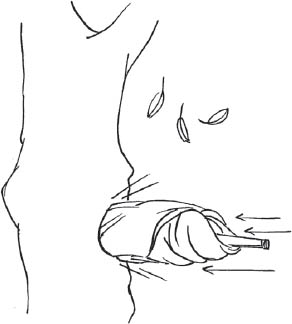
Beyond a bottle showing noticeable heat damage, oxidation, or emitting a downright rotten smell (see “Awful Aromas,” page 70), there are a few other wine emergencies you will likely face at some point. Here’s how to stay calm and carry on.
Lusting over a bottle when you’ve got no corkscrew can induce panic. Fortunately, there are surprisingly effective alternatives to getting your bottle open.
Use Nature: Remove the foil cap and wrap the bottle in a towel, a jacket, or any other soft cloth. Gently but firmly begin to hit the bottom of the bottle against a large tree. Repeat this action until the cork almost pops out, then pull the whole thing out with your hands. Note: If you’re performing this operation on sparkling wines, make sure you let the bottle rest (and the bubbles settle) somewhere cold for ten to fifteen minutes before pulling the cork out entirely. Otherwise, you could have a major explosion.

Get Your Toolbox: Insert a longish, wide-grained screw into the cork. When about half an inch of the screw is sticking out, pull the screw directly up with a pair of pliers or the claw of a hammer.
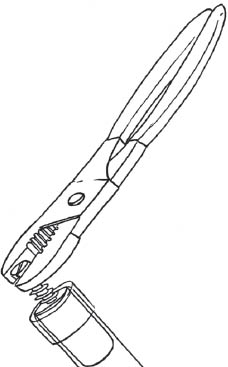
Go Fishing: Locate a wire coat hanger and bend the top to make a straight wire with a very small hook on the end. Gently insert this in between the bottle and the cork until the little hook rests below the bottom of the cork. Rotate the hanger until the hook pierces the cork. Pull up.
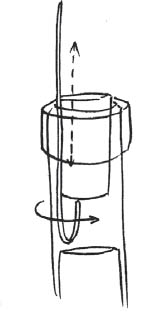
When a cork breaks, it can be a real bummer. Here are your options.
(a) If the cork is broken, but part of it is still stuck in the neck of the bottle . . .
If you have an Ah-So (see page 16) available, now is the time to use it. Gently slip the prongs in between the cork and bottle and slowly pull up. If you don’t have this handy tool, you can carefully keep working on the cork with the wine opener you have or you can push the remainder of the cork into the wine and skip ahead to the next problem.
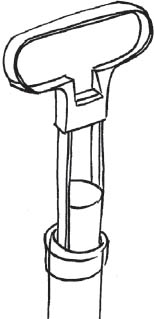
(b) If the cork fell apart and part of it is stuck in the wine . . .
Grab a mesh strainer (the finer the better) or a coffee filter. Slowly pour the wine through the strainer or filter into another container, catching the cork bits along the way. Don’t worry about aesthetics; the container can be a pitcher, vase, large measuring bowl—any vessel that will allow you to pour the wine out again easily. (Because when all the cork drama is over, you’re going to drink the wine.)
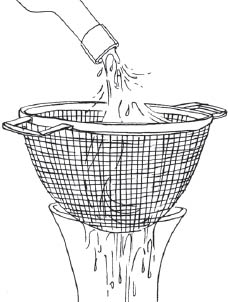
Looks like: Little bits of cork.
What it is: Little bits of cork.
What to do: See Emergency Two (b).
Looks like: Dark, solid, dried bits of wine that sink to the bottom or sides of the bottle or glass.
What it is: Sediment.
What to do: You can ignore (ingesting a bit of sediment will not hurt you) or separate the sediment from your wine by decanting (see page 132).
Looks like: Crystal-like formations on the bottom of the bottle or the underside of the cork. Most often found in white wines.
What it is: Potassium bitartrate crystals. These tasteless and harmless crystals (which are the same as cream of tartar) are natural little bits of tartaric acid that separate from some white wines when they see a rapid, extreme drop in temperature.
What to do: Ignore them. They will likely remain stuck to the cork or bottom of the bottle. The presence of potassium bitartrate crystals is not a fault. Drink on.
If you’re about to serve a wine and suddenly find it’s too hot, submerge the bottle in a bucket or sink filled with ice and water. In five (for reds), ten (for whites or rosés), or fifteen (for sparkling wines) minutes, you should be good to go.

If you find your wine is too cold, use ambient temperature to your advantage. Either pour the wine into a decanter for ten minutes or pour small servings into wineglasses. If using glasses, let the wine sit alone for a few minutes or cup the glass in your hands, allowing the heat from your body to warm it.
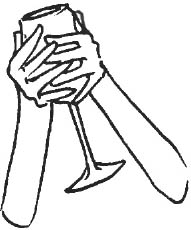
Running out of wine may be the worst kind of emergency there is, and one that’s hard to fix without leaving the party. Your best bet is to take preliminary measures to ensure you always have enough on hand. Opposite is a handy guide to help you calculate how much wine you’ll need.
Remember, don’t pour too much at once. A small serving (around two ounces) will do for tastings, and a half-glass pour (three to four ounces) is perfect for dinners or events where people are sticking to one wine.
|
LIGHTER DRINKERS |
HEAVIER DRINKERS |
WINE TASTING |
|
|
|
one bottle for every ten people |
one bottle for every ten people, plus an extra bottle or two of each wine so people can go back to their favorites after the tasting is over |
SIT-DOWN DINNER |
|
|
|
one bottle for every two people |
one bottle per person |
COCKTAIL PARTY (1-2 HOURS) |
|
|
|
one bottle for every three people |
one bottle for every two people |
COCKTAIL PARTY (3-4 HOURS) |
|
|
|
one bottle for every two people |
one bottle per person |
How long does an open bottle of wine last? The simple answer is, however long it tastes good to you. The more complex answer is that wine starts breaking down as soon as you open the bottle and the wine is exposed to oxygen. The vibrancy and fruit will never again be as bright and shiny as when you first heard that pop (or crack if you’ve got a wine with a screw cap). After that, it’s on a slippery slope to becoming vinegar. Delicate wines, like old wines or wines with bubbles, can be toast by the end of the night. Heartier wines—those with a lot of sugar, alcohol, acidity, or tannin to preserve them—can last a little longer. The true test is your taste buds. If a wine still tastes good to you on the third or fourth day, by all means, drink it. If it starts tasting droopy, chances are that its short life is over. The best prevention for premature demise is to drink the whole bottle on the night you open it. Go ahead; you now have my professional advice as an excuse.
Here are a few tricks that will help you prolong a wine’s life, once you open the bottle.
1. Keep it cool. Heat accelerates aging even after the bottle is open. Store unfinished whites and reds in the fridge.
2. Pump your unfinished wine bottle with an inert gas or a Vacu Vin, a handy mini pump that manually removes oxygen. A few shots of inert gas displace the oxygen in the bottle before you recork it. Both are available at most wine stores.
3. Save an empty half-bottle (375 ml) or two to have on hand. When you drink only half of a regular-size (750 ml) bottle, pour its remaining contents into the little bottle, stop it up, and store it in the fridge. You will leave only a tiny amount of the wine exposed to the dreaded evils of oxygen.
One memorable way to share wine is to open a large bottle. Big bottles are rare and interesting. They never fail to impress. The wine in them also ages more slowly, as there is a smaller amount exposed to oxygen, so you can sometimes find older vintages in large formats. Here’s a quick reference to the most popular bottle sizes.
|
VOLUME |
BOTTLES |
GLASSES |
SPLIT |
187 ml |
|
|
HALF |
375 ml |
|
|
BOTTLE |
750 ml |
|
|
MAGNUM |
1.5 L |
|
|
JEROBOAM |
3 L |
|
|
METHUSELAH |
6 L |
|
|
SALMANAZAR |
9 L |
|
|
BALTHAZAR |
12 L |
|
|
NEBUCHADNEZZAR |
15 L |
|
|
Wine makes an awesome gift for beginners and connoisseurs alike. Putting a little thought and creativity into what you select will make it even more special. These are some of my favorite gifts for oenophiles.
Throughout this book, you’ll find recommendations for wine I love; you can peruse these lists for inspiration. Another thought is to choose a bottle that is special to you and explain why with an enclosed note. Or you can look for a bottle with a specific vintage year to commemorate an event. For example, if a coworker is getting married in 2014, you can buy a bottle from that year with instructions that she should drink it on her tenth anniversary. For wines that people will be able to enjoy over the long term, look to the red or sweet wines of Bordeaux, France, or vintage Ports from Portugal.
Buy someone a large-format version of a favorite wine.
A special opener is a great gift because the recipient will think of you every time they uncork a bottle.
Receiving a special bottle nested beside well-partnered cheeses is kind of like getting a party in a box (see “Cheese Pairing Guide: Thirty Top Cheeses and Their Perfect Wine Partners,” page 148).
You can go a lot of different directions with this gift. Two beautiful glasses are always a welcome gift—eight or ten is usually better.
Combine a bottle of Banyuls or vintage Port with some artisan chocolate for a decadent present.
A splurge for many, decanters make beautiful, useful wine gifts.
A beautiful wine bucket is something you’re less likely to buy yourself, but it can really come in handy when entertaining.
Wine club memberships can come in many shapes and forms. You could sign someone up for a wine club from a specific winery (sometimes the only way to get certain highly coveted bottles) or from a shop that aggregates great selections. Both wineries and shops usually offer a range of options based what you’d like to spend, and how often you’re up for spending it (see “Join Wine Clubs,” page 194).